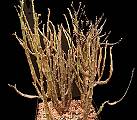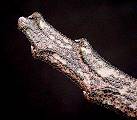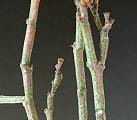|
Dead sticks Euphorbia platyclada from Madagascar The unusual, flat and
leafless joints make the impression that there is something wrong with this
plant. If it stands in full sun, E.platyclada turns a strong brown to red in
colour. A well grown plant really does look almost dead. |
||
|
|
E.platyclada occurs in
various forms, with short or long segments, little or strongly branched,
squat or very upright. All these forms have the flat segments in common. Most of the commercially
available so-called E. platyclada var.hardyi are one of these
forms. Donít fall for it, the real var.hardyi differs clearly by having
(almost) cylindrical stems. Despite looking the most
interesting when grown in full sun, cultivation on the semi-shady window sill
is also possible and produces faster growing plants. Also outside the main
flowering season from June until October new cyathia appear. Larger specimens
are almost constantly in flower. The bisexual cyathia are
small and insignificant and often only get noticed by the yellow pollen. As
they are self-fertile, one plant is enough for seed production. If the small
insects havenít already pollinated them, you can help out with the paint
brush. The seed germinates one to
three weeks after sowing, and already one-year old seedlings can flower. Also
propagation by cuttings presents no problems. † Like all† Madagascan euphorbias E.platiclada should
also spend the winter warm (min. 15 įC) and not completely dry. |
|
|
Similar species with the same
cultivation requirements are: - E. platyclada var. hardyi: with almost cylindrical segments - E. bosseri: with cylindrical segments, less branched Sources for E. platyclada: DE: Uhlig-Kakteen DE: Exotica, Botanische Raritšten FR : Cacteus US: Aridlands US: Bob Smoley |
||
If you found this page without a left frame
please load www.euphorbia.de







